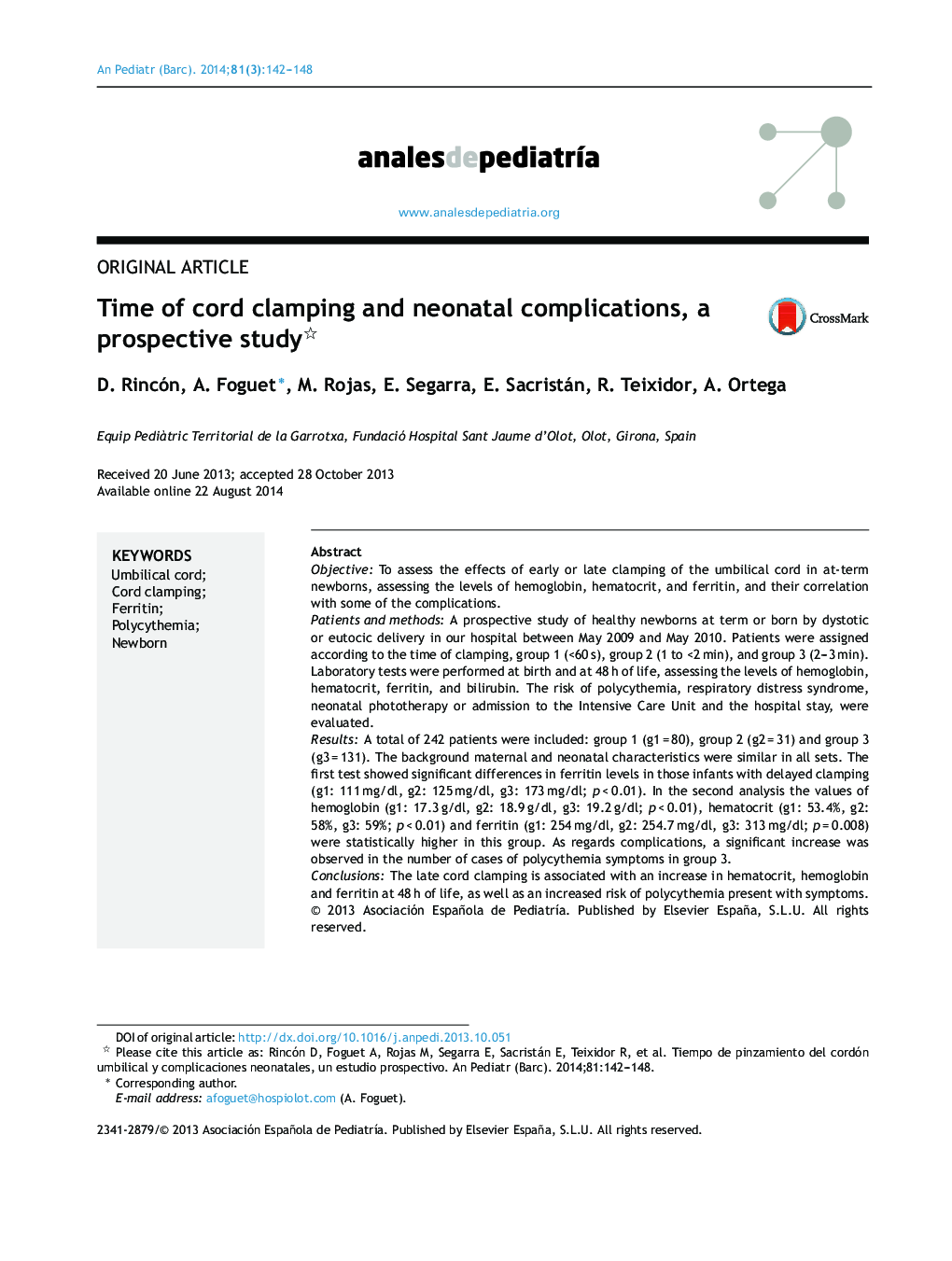| کد مقاله | کد نشریه | سال انتشار | مقاله انگلیسی | نسخه تمام متن |
|---|---|---|---|---|
| 4145291 | 1272600 | 2014 | 7 صفحه PDF | دانلود رایگان |
ObjectiveTo assess the effects of early or late clamping of the umbilical cord in at-term newborns, assessing the levels of hemoglobin, hematocrit, and ferritin, and their correlation with some of the complications.Patients and methodsA prospective study of healthy newborns at term or born by dystotic or eutocic delivery in our hospital between May 2009 and May 2010. Patients were assigned according to the time of clamping, group 1 (<60 s), group 2 (1 to <2 min), and group 3 (2–3 min). Laboratory tests were performed at birth and at 48 h of life, assessing the levels of hemoglobin, hematocrit, ferritin, and bilirubin. The risk of polycythemia, respiratory distress syndrome, neonatal phototherapy or admission to the Intensive Care Unit and the hospital stay, were evaluated.ResultsA total of 242 patients were included: group 1 (g1 = 80), group 2 (g2 = 31) and group 3 (g3 = 131). The background maternal and neonatal characteristics were similar in all sets. The first test showed significant differences in ferritin levels in those infants with delayed clamping (g1: 111 mg/dl, g2: 125 mg/dl, g3: 173 mg/dl; p < 0.01). In the second analysis the values of hemoglobin (g1: 17.3 g/dl, g2: 18.9 g/dl, g3: 19.2 g/dl; p < 0.01), hematocrit (g1: 53.4%, g2: 58%, g3: 59%; p < 0.01) and ferritin (g1: 254 mg/dl, g2: 254.7 mg/dl, g3: 313 mg/dl; p = 0.008) were statistically higher in this group. As regards complications, a significant increase was observed in the number of cases of polycythemia symptoms in group 3.ConclusionsThe late cord clamping is associated with an increase in hematocrit, hemoglobin and ferritin at 48 h of life, as well as an increased risk of polycythemia present with symptoms.
ResumenObjetivoEvaluar los efectos del pinzamiento precoz o tardío del cordón umbilical en recién nacidos a término y su correlación con los niveles de hemoglobina, hematocrito, ferritina y ciertas complicaciones neonatales.Pacientes y métodosEstudio prospectivo en recién nacidos sanos, a término, nacidos por parto eutócico o distócico en nuestro hospital, entre mayo del 2009 y mayo del 2010. Se asignó a los pacientes según el tiempo de pinzamiento: grupo 1 (<60 s), grupo 2 (1 a <2 min) y grupo 3 (2 a 3 min). Se realizaron análisis al momento del nacimiento y a las 48 h de vida, valorando los niveles de hemoglobina, hematocrito, ferritina y bilirrubina. Se evalúo el riesgo de aparición de policitemia, síndrome distrés respiratorio, fototerapia o ingreso en la Unidad de Cuidados Intensivos neonatal y el tiempo de estancia hospitalaria.ResultadosSe incluyó a 242 pacientes: grupo 1 (g1=80), grupo 2 (g2=31) y grupo 3 (g3=131). Los antecedentes maternos y las características neonatales fueron similares en todas las categorías. El primer análisis demostró diferencias significativas en los niveles de ferritina de aquellos recién nacidos con pinzamiento más tardío (g1: 111 mg/dl, g2: 125 mg/dl, g3: 173 mg/dl; p<0,01). En el segundo análisis los valores de hemoglobina (g1: 17,3 g/dl, g2: 18,9 g/dl, g3: 19,2 g/dl; p<0,01), hematocrito (g1: 53,4%, g2: 58%, g3: 59%; p<0,01) y ferritina (g1: 254 mg/dl, g2: 254,7 mg/dl, g3: 313 mg/dl; p=0,008), fueron estadísticamente mayores en este mismo grupo. Al evaluar las complicaciones, observamos un aumento significativo en el número de casos de policitemia asintomática en el grupo 3.ConclusionesEl pinzamiento tardío del cordón umbilical se asocia a un aumento en los niveles de hemoglobina, hematocrito y ferritina a las 48 h de vida y en el número de casos de policitemia asintomática.
Journal: Anales de Pediatría (English Edition) - Volume 81, Issue 3, September 2014, Pages 142–148
